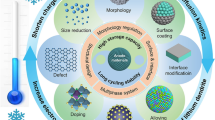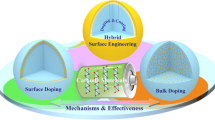Abstract
The electrochemical behavior of a symmetrical cell, Pt/Ce0.8Sm0.2O1.9−δ/Pt, under reducing conditions and wide temperature range (250 – 600 °C) is detailed. In terms of the charge carriers transport through the electrolyte microstructure, AC impedance spectroscopy has been applied to address useful concerns about the transport properties over electrolytic and mixed conduction regimes. The impedance spectra at lower temperature and oxygen partial pressure show the electrochemical response of separated bulk and grain boundary contributions. The increase in the electronic conductivity from 250 to 400 °C shows that the electrochemical reduction Ce4+/Ce3+ is as kinetic as thermodynamically favorable in the experimental conditions. In a typical Nyquist plot of an impedance diagram, until temperatures as low as 400 °C, the high and low frequency arcs can be accessed and the influence of reducing atmosphere over both the components is presented. The apparent activation energy for the electronic process (ΔE) extracted from the total conductivity is 2.54 eV. Distinguished bulk (2.34 eV) and grain boundary (2.63 eV) activation energies point the latter as an energetic barrier in the redox reaction. The oxygen partial pressure dependence of individual capacitances suggests storage of electrical charge along grain boundaries which can potentially behave as a chemical capacitor.











Similar content being viewed by others
References
W.C. Chueh, C. Falter, M. Abbott, D. Scipio, P. Furler, S.M. Haile, A. Steinfeld, Science 330, 1797 (2010)
W.C. Chueh, Y. Hao, W. Jung, S.M. Haile, Nat. Mater. 11, 155 (2012)
E.C.C. Souza, W.C. Chueh, W. Jung, E.N.S. Muccillo, S.M. Haile, J. Electrochem. Soc. 159, K127 (2012)
H.L. Tuller, A.S. Nowick, J. Electrochem. Soc. 122, 255 (1975)
H. Yahiro, K. Eguchi, H. Arai, Solid State Ionics 36, 71 (1989)
M. Gödickemeier, L.J. Gauckler, J. Electrochem. Soc. 145, 414 (1998)
B.C.H. Steele, Solid State Ionics 129, 95 (2000)
M. Mogensen, N.M. Sammes, G.A. Tompsett, Solid State Ionics 129, 63 (2000)
T. Matsui, M. Inaba, A. Mineshige, Z. Ogumi, Solid State Ionics 176, 647 (2005)
W. Lai, S.M. Haile, J. Am. Ceram. Soc. 88, 2979 (2005)
J. Maier, Physical chemistry of ionic materials – ions and electrons in solids, 1st edn. (John Wiley & Sons, England, 2004), pp. 312–352
T. Shimonosono, Y. Hirata, Y. Ehira, S. Sameshima, T. Horita, H. Yokokawa, Solid State Ionics 174, 27 (2004)
T. Matsui, T. Kosaka, M. Inaba, A. Mineshige, Z. Ogumi, Solid State Ionics 176, 663 (2005)
S. Lubke, H.D. Wiemhofer, Solid State Ionics 117, 229 (1999)
W.C. Chueh, W. Lai, S.M. Haile, Solid State Ionics 179, 1036 (2008)
T. Kobayashi, S. Wang, M. Dokiya, H. Tagawa, T. Hashimoto, Solid State Ionics 126, 349 (1999)
E.C.C. Souza, E.N.S. Muccillo, J. Alloys Compd. 473, 560 (2009)
Y.M. Chiang, E.B. Lavik, I. Kosacki, H.T. Tuller, J. Electroceram. 1, 7 (1997)
W.C. Chueh, S.M. Haile, Phys. Chem. Chem. Phys. 11, 8144 (2009)
J. Jamnik, J. Maier, Phys. Chem. Chem. Phys. 3, 1668 (2001)
W.C. Chueh, A.H. McDaniel, M.E. Grass, Y. Hao, N. Jabeen, Z. Liu, S.M. Haile, K.F. McCarty, H. Bluhm, F.E. Gabaly, Chem. Mater. 24, 1876 (2012)
Acknowledgments
The author gratefully acknowledge the professor Sossina M. Haile for the teaching and for the experimental facilities used in this work which were supported by the U.S National Science Foundation through the Caltech Center for the Science and Engineering of Materials, a Materials Research Science and Engineering Center (DMR-052056). Financial support from the following agencies: Sao Paulo Research Foundation (FAPESP), Brazilian National Nuclear Energy Commission (CNEN). Additional financial support was provided by FAPESP to E.C.C. Souza.
Author information
Authors and Affiliations
Corresponding author
Rights and permissions
About this article
Cite this article
Souza, E.C.C. Electrochemical properties of doped ceria electrolyte under reducing atmosphere: Bulk and grain boundary. J Electroceram 31, 245–253 (2013). https://doi.org/10.1007/s10832-013-9826-8
Received:
Accepted:
Published:
Issue Date:
DOI: https://doi.org/10.1007/s10832-013-9826-8




